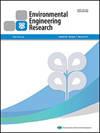Carbon dioxide utilization in lithium carbonate precipitation: A short review
IF 3
4区 环境科学与生态学
Q3 ENGINEERING, ENVIRONMENTAL
引用次数: 0
Abstract
The market for lithium-ion batteries (LiBs) is growing rapidly, the demand for lithium (Li) in the form of lithium carbonate (Li2CO3), which is the most common lithium mineralization form, is therefore also increasing significantly. Li is conventionally extracted as Li2CO3 using sodium carbonate (Na2CO3) to precipitate Li ions in an aqueous Li solution. However, Na2CO3 can also be replaced by CO2, which highlights the potential of using CO2 as a sustainable and economically viable alternative. This review focuses on technologies that utilize CO2 for Li2CO2 precipitation. First, the use of CO2 gas and Na2CO3 as carbonate sources are compared, and the need to consider important operating conditions with CO2 bubbling are then presented. Attempts made to increase the specific surface area of the reaction surface to enhance the utilization of CO2 gas and to produce micro-sized Li2CO3 powders are then reported, and the limitations associated with CO2 gas utilization are discussed. Although CO2 precipitation has limitations in terms of efficiency, scalability, and the fine-tuning of reaction conditions, this review shows that if CO2 precipitation technology is further developed, its use could be key to extracting and recycling next-generation Li.二氧化碳在碳酸锂沉淀中的利用:简评
锂离子电池(LiBs)市场正在快速增长,因此对碳酸锂(Li2CO3)形式的锂(Li)(这是最常见的锂矿化形式)的需求也在大幅增加。传统的锂提取方法是使用碳酸钠(Na2CO3)使锂水溶液中的锂离子沉淀为 Li2CO3。然而,Na2CO3 也可以用二氧化碳代替,这就凸显了二氧化碳作为一种可持续且经济可行的替代品的潜力。本综述重点介绍利用 CO2 沉淀锂离子的技术。首先,比较了使用二氧化碳气体和 Na2CO3 作为碳酸盐源的情况,然后介绍了考虑二氧化碳鼓泡的重要操作条件的必要性。然后,报告了为提高 CO2 气体的利用率和生产微小尺寸的 Li2CO3 粉末而增加反应表面比表面积的尝试,并讨论了与 CO2 气体利用相关的局限性。虽然二氧化碳沉淀在效率、可扩展性和反应条件的微调方面存在局限性,但本综述表明,如果二氧化碳沉淀技术得到进一步发展,其应用将成为提取和回收下一代锂的关键。
本文章由计算机程序翻译,如有差异,请以英文原文为准。
求助全文
约1分钟内获得全文
求助全文
来源期刊

Environmental Engineering Research
Environmental Science-Environmental Engineering
CiteScore
7.50
自引率
5.70%
发文量
80
期刊介绍:
The Environmental Engineering Research (EER) is published quarterly by the Korean Society of Environmental Engineers (KSEE). The EER covers a broad spectrum of the science and technology of air, soil, and water management while emphasizing scientific and engineering solutions to environmental issues encountered in industrialization and urbanization. Particularly, interdisciplinary topics and multi-regional/global impacts (including eco-system and human health) of environmental pollution as well as scientific and engineering aspects of novel technologies are considered favorably. The scope of the Journal includes the following areas, but is not limited to:
1. Atmospheric Environment & Climate Change: Global and local climate change, greenhouse gas control, and air quality modeling.
2. Renewable Energy & Waste Management: Energy recovery from waste, incineration, landfill, and green energy.
3. Environmental Biotechnology & Ecology: Nano-biosensor, environmental genomics, bioenergy, and environmental eco-engineering.
4. Physical & Chemical Technology: Membrane technology and advanced oxidation.
5. Environmental System Engineering: Seawater desalination, ICA (instrument, control, and automation), and water reuse.
6. Environmental Health & Toxicology: Micropollutants, hazardous materials, ecotoxicity, and environmental risk assessment.
 求助内容:
求助内容: 应助结果提醒方式:
应助结果提醒方式:


